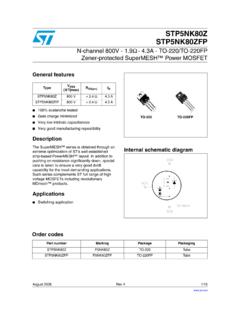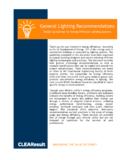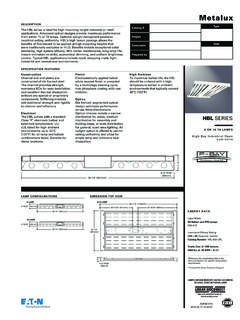Transcription of Electronic transformer for a 12V halogen lamp - …
1 APPLICATION NOTE1/4AN528/0999 Electronic transformer FOR A 12V halogen LAMPby P. Fichera, R. Scollo1. INTRODUCTIONL ighting that uses halogen lamps is commonly foundin residential environments, where it offers a warmlight in comparison with that generated by fluorescenttubes, and greater efficiency than conventionalfilament lamps are available with voltage ratings of 6,12 or 24 Volts, and so a transformer is needed inorder to provide the lamp with a low voltage supplyfrom either 110V or 220V mains. They aregenerally available with power ratings of 50, 75, 100and 250 Electronic transformer represents an alternativemeans of power conversion to the more standardiron core, 50Hz transformer advantages of the Electronic transformercompared with the classical solution are: The output power from the Electronic transformerto the lamp can be varied, thus dimming controlcan be added; It is possible to include protection against shortcircuit of the lamp filament; Weight can be reduced and the construction mademore compact.
2 And Acoustic noise (mains hum) is THE Electronic SOLUTIONThe topology of the circuit is the classic control circuit could be realised using an IC (sofixing the operating frequency), but there is a moreeconomical solution which consists of a self-oscillating circuit where the two transistors are drivenin opposing phase by feedback from the output CIRCUIT DESCRIPTIONThe line voltage is rectified by the full-bridge rectifier,generating a semi-sinusoidal voltage at double theline frequency. The diac starts to conduct duringeach cycle, starting the half-bridge oscillation. Theturn-on of the diac can be varied by modifying thetime constant of the RC network formed by R andRT'1T''1T1DC2TR1TR2C1C3 Figure 1. Electronic transformer for 12V halogen LampAPPLICATION NOTE2/4C1. This can be varied to provide a lamp the cycle has started, the diode D maintainsthe voltage across C1 at a value less than the diacconduction threshold voltage, so the transistor canswitch frequency of oscillation depends mainly uponthe size and maximum flux density of the core usedin the feedback transformer , and the storage time ofthe transistors.
3 When the cycle has started, thecurrent in the feedback transformer increases untilthe core saturates. At this point the feedback driveof the active transistors is therefore removed, and,once its storage time has passed, it turns off. In thisapplication the oscillation frequency would be around35kHz, generally around ten times the naturalfrequency of the dependence upon the storage time is minimisedby the RC network at the base of the transistor,which increases the rate of charge extraction fromthe base at turn-off. The network also serves todecouple the base from the oscillation caused bythe base transformer at turn-off, preventing spuriousturn-on of the anti-parallel diodes allow current to flow whendevices are Short Circuit ProtectionFigure 2 shows a circuit with circuitry to protectagainst a short circuit of the load added (note - somecomponents have been removed for clarity). Thecircuit operates as short circuit of the lamp will cause an excessivecurrent to flow through the transistors, which willeventually cause them to overheat and be , this current will also cause the voltageacross RE to increase.
4 This causes transistor TRS toturn on, which in turn prevents the diac from triggeringthe circuit at the start of each cycle. RS and CS serveto delay the turn-on of the transistor, preventing theprotection being triggered during the inrush phase atthe turn on of the lamp (when the lamp filament iscold, it has a very low resistance, causing a largebut brief current to flow through the transistors atturn-on. This resistance increases when the lampheats up, and the current through the transistorsfalls to its steady-state value). Diode DS preventsthe small-value resistor RE disrupting the operationof the a short time (a few operating cycles), thecapacitor CS will become discharged and so will beunable to keep TRS turned on, and the circuit willattempt to restart itself. If the fault condition stillRECSRSDSTRSF igure 2. transformer with short-circuit protection added (shown shaded grey)3/4 APPLICATION NOTE exists, the protection will be re-triggered after ashort time.
5 In this way the circuit limits the energydissipated by the should be noted that the transistor must be robustenough to withstand the fault condition while theshort circuit protection reacts - that is to say deviceswith a large RBSOA must be TRANSISTOR SELECTIONB ecause of the tight cost constraints and the voltagerange of this application, the bipolar is the usualchoice of transistor. The voltage and current ratingsof the power devices used must be selected basedon the circuit topology, the required output powerand the frequency of Voltage ratingThe required voltage rating of the devices is definedby the half-bridge topology. Supplying the circuitwith 220V RMS mains, calculating peak value,and adding a safety margin, gives a maximum supplyvoltage VCC of:VCC(max)=220V x 2 + 10%=310V + 10%. this figure must also be added the overvoltagegenerated by the input filter at turn-off. In practice,devices are used with a rating of:VCE(max) = 450 - Current ratingThe nature of the half-bridge topology is such that innormal operation, half the supply voltage is droppedacross each device, so from the above figures VCEin the steady state is 310V /2, 155V.
6 Hence thecollector current in the steady state can be calculatedusing:POUT=IC(RMS) . VCE(RMS)VCE(RMS)=1/2 . VmainsIC(RMS)=2. POUT VmainsIC(RMS)=IC(peak) 2IC(peak)=2 . 2 . POUT Vmains=2 . 2 . 50W 220 VIC(peak)= stated above, when the circuit is first turned on,the low initial resistance the lamp filament causes alarge current to flow through the transistors. Thiscurrent can be up to ten times the current in thesteady state, and the devices must be selected towithstand this example then it is recommended that thedevice used is bipolar transistor, rated at 450V andaround 7A. An example is the BUL38-D, which alsoincorporates an integrated anti-parallel Storage and fall timesThe fall time, tfall, of the transistors influences thelosses of the circuit, while the storage time, ts, isimportant as it affects the switching frequency of theconverter. The nature of the processes used toproduce bipolar transistors means that the storagetime between batches of transistors may varyconsiderably.
7 The transistors used must bemanufactured, tested and selected to have storagetimes within certain with too large a storage time may causethe circuit to oscillate below the operating limits ofthe output transformer , causing saturation of thecore towards the end of each cycle. This will causea spike in the collector current of the transistorsevery cycle, which will eventually cause them tooverheat and be POWER FACTOR CORRECTIONAs the capacitor at the input of the circuit is relativelysmall, there is little deformation of the input currentwaveform. However, this type of circuit generates acertain amount of electro-magnetic interference, dueto the high frequency source that feeds the resonantnetwork, and so a suitable filter must be inserted inthe circuit before the rectifier bridge to prevent thisinterference being fed back to the mains. This filtermust satisfy VDS and UL norms concerningmaximum RFI levels, clearance and creepagedistances and the frequency response of the transformers can offer an economic,simple and compact alternative to the traditional50Hz transformer .
8 This technique is particularlyuseful in halogen lamp applications because of theshort circuit protection, reduced weight, absence ofacoustic noise and the possibility of including adimming NOTE4/4 The simple general circuit shown and the guidancegiven in choosing a suitable transistor should providea useful starting point for developing more furnished is believed to be accurate and reliable. However, STMicroelectronics assumes no responsibility for the consequencesof use of such information nor for any infringement of patents or other rights of third parties which may result from its use. No license isgranted by implication or otherwise under any patent or patent rights of STMicroelectronics. Specification mentioned in this publication aresubject to change without notice. This publication supersedes and replaces all information previously supplied. STMicroelectronics productsare not authorized for use as critical components in life support devices or systems without express written approval of ST logo is a trademark of STMicroelectronics 1999 STMicroelectronics - Printed in Italy - All Rights ReservedSTMicroelectronics GROUP OF COMPANIESA ustralia - Brazil - China - Finland - France - Germany - Hong Kong - India - Italy - Japan - Malaysia - Malta - Morocco - Singapore - Spain - Sweden - Switzerland - United Kingdom - transformer Design-in GuidelinesTypePackageTypicalApplicationB UL39D*BUL38D*BUL49D*BUL58D*BUL59 BUL67 BUL510 BUL89 BUL8104004504504504004504004504508508008 50850800700100085010004558810101215TO-22 0TO-220TO-220TO-220TO-220TO-220TO-220TO- 220TO-2187080809085100100110125up to 50 Wup to 75 Wup to 75 Wup to 105 Wup to 105 Wup to 150 Wup to 150 Wup to 250 Wup to 300 WVcew(V)Vces/Vcev(V)Ic(A)Ptot(W)*Integra ted freewheeling dio













